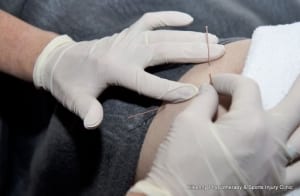Home / Treatments Offered / Deep Dry Needling
There are 2 types of Dry Needling; Superficial Dry Needling (SDN) and Deep Dry Needling (DDN).


In KPC, only our highly trained physiotherapists who have completed extra training carry out DDN. It involves the use of sterile, single-use, disposable needles. First of all, the physiotherapist palpates the trigger point and then they insert a needle into the point. As a result, the client will feel the LTR, which feels like a spasm or twitch in the muscle. Pain may be referred away from the trigger point, usually distally. The LTR can be elicited repeatedly, or else the needle may be ‘wound-up’ in the muscle to stretch the fibres. We may use more than one needle during a session, and the session usually lasts between 5 and 20 minutes.
The main difference between DDN and Acupuncture is the theory and reasoning behind them. Acupuncture is based on the Chinese theory of Meridians, Balance of Yin and Yen, Energy flow etc. In contrast, Deep Dry Needling is Western based and widely researched. It is based on a theory of chemical build up in Myofascial Trigger Points.
Although the techniques are similar, the physiological outcome differs hugely. The only similarity is use of similar needles which are extremely fine, sterile and flexible. They are usually around 0.15mm to 0.3mm in diameter.
Why choose DDN?
For patients with active Myofascial Trigger points
For patients whose symptoms are resistant to treatment
As an adjunct to other physiotherapy techniques
Treat primary and secondary trigger points with other Muscle release techniques
To identify referral sources
Chronic Pain
Aims of Deep Dry Needling
As DDN is an invasive technique, there may be side effects. However, these will all be outlined to you before it is carried out.
Local side effects:
Autonomic side effects:
MONDAY – FRIDAY
8am – 9pm
SATURDAY
9am – 2pm
SUNDAY
Closed